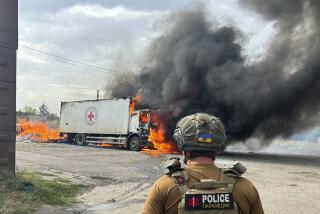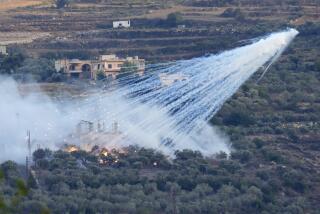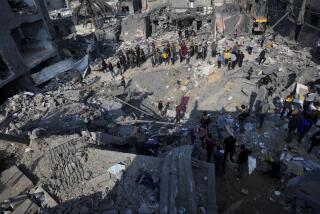Red Cross Seeks Suspension in the Use of Cluster Bombs
- Share via
GENEVA — The Red Cross is urging governments to suspend the use of cluster bombs--like those NATO dropped on Kosovo last year--because they can kill and maim long after a war ends, an official said Tuesday.
A new study by the International Committee of the Red Cross found that, compared with land mines, those injured or killed by cluster bombs were 4.9 times as likely to be children younger than 14.
The 50-page report focused on the aftermath of the North Atlantic Treaty Organization’s 78-day bombing campaign in Yugoslavia.
Children are especially at risk because the bombs are usually an eye-catching yellow with little parachutes attached, said Peter Herby, a Red Cross specialist.
“People think they are duds because they didn’t go off at first, but they are highly unstable and can be set off easily,” Herby added.
The Red Cross found that cluster bombs killed 50 people and injured 101 in Kosovo--a province of Serbia, the main Yugoslav republic--during the first year after the air campaign ended in June 1999, the report said.
In contrast, land mines, mainly left by Serbian forces, killed 30 people and wounded 169.
Land-mine victims often survive, although they may lose limbs, but cluster bombs generally kill anyone near them when they explode.
Herby said the Red Cross, charged with enforcing the Geneva Conventions on the conduct of war, has sent governments its study with an appeal for a new international law on the weapon.
“The use of cluster bombs should be suspended until an international agreement on their use and clearance has been achieved,” said a message to diplomats in Geneva.
Although cluster bombs were used in the 1991 Persian Gulf War and in Laos during the Vietnam War, Kosovo provided the Red Cross with its first chance to study their long-term impact, Herby said.
A single cluster-bomb canister, dropped to destroy airfields or tanks and soldiers, typically scatters 200 to 600 bomblets over an area the size of a football field.
On average, 10% to 15% of the bomblets fail to explode immediately, but for decades they can be detonated by the slightest disturbance or even a change in the weather, Herby said. Clearing cluster bombs is more dangerous than clearing mines, he added.
The report estimated that 30,000 cluster bomblets remained after the Kosovo conflict. U.N.-supervised clearers had removed 4,069 by the end of May, the report said.
The U.N. operation also reported the clearance of 3,448 antipersonnel mines, 3,784 antitank mines and 6,639 other items of unexploded ordnance.
The Red Cross also called for a ban on the use of cluster bombs against military targets in populated areas and for those who use such bombs to clear them afterward.
More to Read
Sign up for Essential California
The most important California stories and recommendations in your inbox every morning.
You may occasionally receive promotional content from the Los Angeles Times.










